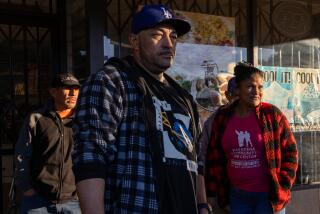Cutting Sugar Cane Can Be Bitter Work
- Share via
APOPA, El Salvador — The first rays of sunlight haven’t peeked over the horizon, but five dozen workers are already waiting to begin chopping sugar cane.
Elsewhere on the Angel plantation, workers are setting fire to fields of ripe cane, which will reduce fiber in the stalks and make it easier to extract sugar at the plantation’s refinery.
Drivers are getting mammoth trucks ready for hauling spiky mounds of cut stalks, and mechanics are checking the mill’s grinders and boilers that will transform the cane into sugar granules poured into a huge underground storage cellar.
The heaviest work for the 600 people toiling on the plantation is done by the cane cutters.
The workers advance across the fields hacking with machetes, bottles of water hung across their backs and hats protecting them from the sun. At the end of the day, each will collect pay of $3.20.
Walter Orellana, 14, sweat streaming down his young face, swings his machete with the power of an adult.
Walter doesn’t go to school because he has to work to help his family survive.
Executives at the Angel plantation, one of nine in the country, deny that they use child labor.
Technically, that’s true. Walter and his friends don’t work directly for the plantation. They cut cane for a variety of farmer cooperatives that supply the plantation with cane.
“We have to work to help our parents,” said Israel Morales, 13, trying to wipe the grimy, sticky mixture of sweat and sugar juice from his palms.
More to Read
Sign up for Essential California
The most important California stories and recommendations in your inbox every morning.
You may occasionally receive promotional content from the Los Angeles Times.












